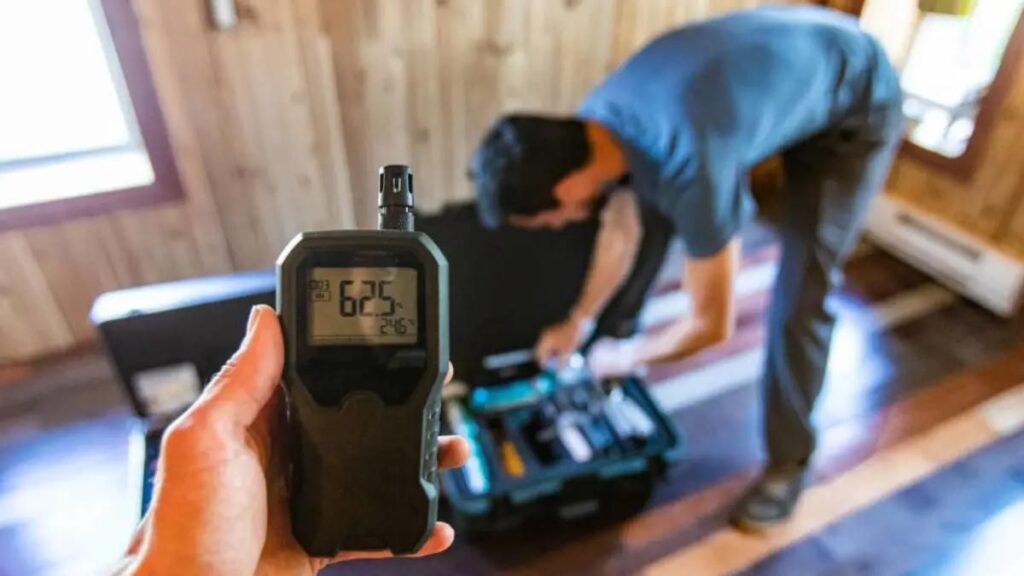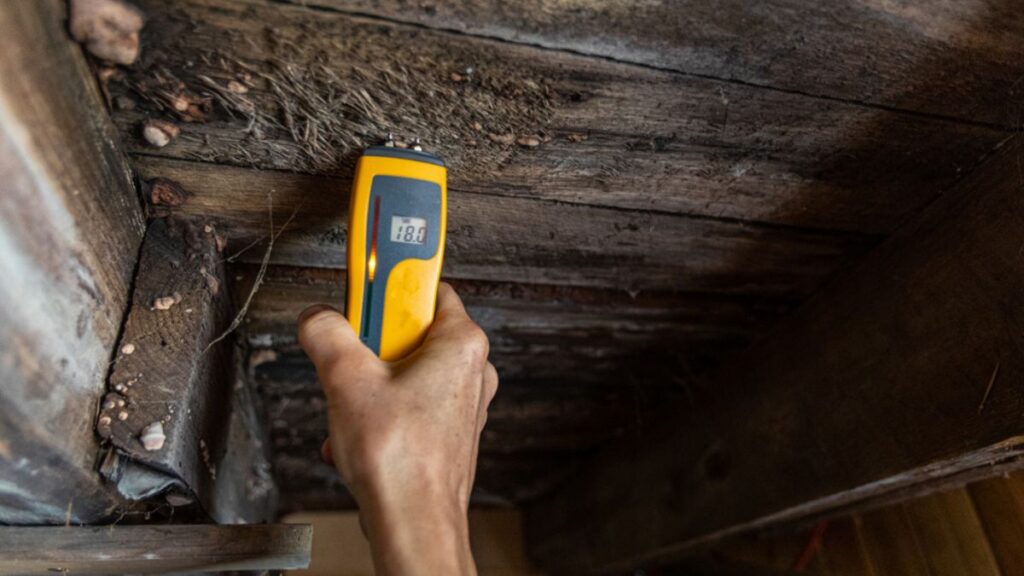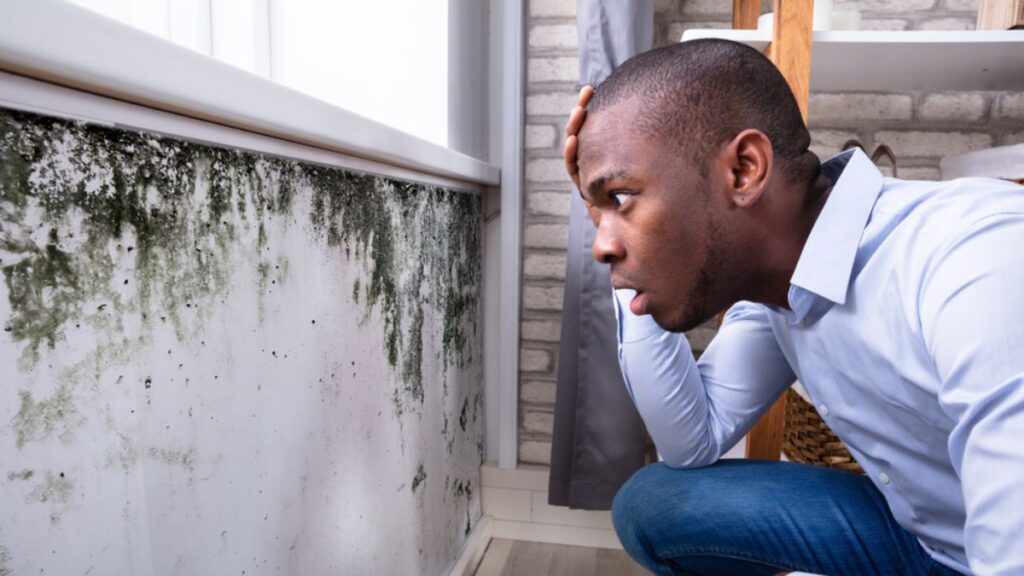Learn about the factors affecting how accurate is a mold inspection and common misconceptions, and understand how to ensure a professional inspection.
The accuracy of a mold inspection can vary based on several factors, including the inspector’s expertise, the methods used for testing, and the extent of the mold problem. Here are some factors that can influence the accuracy of a mold inspection:
- A well-trained, experienced mold inspector will be more likely to accurately identify and assess mold problems than someone with less experience or training. They should be certified by a reputable organization, such as the Indoor Air Quality Association (IAQA) or the American Council for Accredited Certification (ACAC).
- Various methods for detecting mold include visual inspection, surface sampling, air sampling, and bulk sampling. Each method has its strengths and limitations. For example, air sampling can detect mold spores in the air, but it may not be as effective at identifying hidden mold. On the other hand, surface sampling can identify mold on surfaces but won’t detect airborne spores.
- If the mold problem is extensive and obvious, it will be easier to detect. However, if the mold is hidden behind walls or under floors, it may be more difficult to assess the extent of the problem accurately.
- After collecting samples, they are typically sent to a lab for analysis. The accuracy of the lab analysis can also impact the accuracy of the mold inspection.
- Mold levels can vary daily and even from hour to hour. This variability can make it difficult to accurately understand the mold problem based on a single inspection.
It’s important to note that no mold inspection can be 100% accurate. However, by hiring a qualified mold inspector and using a combination of inspection methods, it’s possible to get a fairly accurate assessment of a mold problem.
| Key Takeaways |
|---|
| Mold inspections involve visually inspecting a building for mold growth and conducting tests on air and surfaces to determine the presence and type of mold spores. |
| Mold inspections are important for identifying potential health hazards and determining the need for remediation. |
| Factors affecting mold inspection accuracy include sampling techniques, equipment quality, environmental conditions, and the inspector’s experience. |
| Different types of mold inspections include visual inspection, surface sampling, and air sampling. |
| Factors affecting mold inspection accuracy include sampling techniques, equipment quality, environmental conditions, and the experience of the inspector. |
| Common misconceptions about mold inspections include assuming that all molds are harmful, visible mold growth is the only sign of a problem, and DIY testing kits are as accurate as professional inspections. |
| Hiring a professional mold inspector provides expertise, accurate identification, and appropriate solutions for mold issues. |
| Look for qualifications and certifications when choosing a mold inspector, such as certification from organizations like NORMI or IESO. |
| Insurance coverage for the inspector is important to protect both parties during the inspection process. |
Factors Affecting Mold Inspection Accuracy
Mold inspection accuracy, including how accurate is a mold inspection, can vary depending on the method used and the inspector’s qualifications. Here are some key points from the search results:
- Air mold tests are the most accurate way to determine exposure to mold in indoor environments.
- Professional mold testing is highly reliable and extremely accurate, assuming that the mold testing company is reputable and qualified and has a strong track record of success in their community.
- Tape lift tests can accurately determine if mold grows on a particular surface.
- Home mold testing kits use “settle plate applications” and are generally less accurate than professional testing.
Note: Choosing a qualified mold inspector is crucial for accurate results, especially with hazardous substances like black mold. Regular inspections are necessary due to varying mold levels over time and in different building areas to ensure ongoing safety.

The Basics of Mold Inspection
Mold inspection involves visually inspecting and testing for mold growth and spores, including measuring indoor mold spore counts. Its purpose is to identify health hazards and determine if remediation is needed due to the serious risks mold can pose.
In addition to causing physical discomfort and damaging property, including walls, ceilings, and furniture, mold can also pose health risks. Therefore, accuracy in mold inspections, including proper sampling of mold samples, is crucial to identify and address the problem effectively.
The Importance of Accuracy in Mold Inspections
Understanding how accurate a mold inspection can be is important, as it can vary depending on factors such as the method used, the qualifications of the inspector, and the period of time involved.
Inaccurate mold inspections can be costly and dangerous. If a mold problem goes undetected or is improperly treated, it can grow and spread quickly throughout the building. This can lead to more extensive property damage and increased health risks for occupants.
Furthermore, inaccurate diagnoses can result in unnecessary remediation efforts that fail to fix the problem at hand. Not only does this waste time and money, but it also prolongs exposure risk for those who live/work in affected areas.
Inaccurate testing methods may also produce false negatives or positives, leading to incorrect conclusions about severity levels or appropriate action measures. For these reasons alone, accuracy must not be overlooked during any phase of an inspection project.
Air Testing for Mold Deemed Unreliable by CDC
According to the Centers for Disease Control and Prevention (CDC), routine mold sampling is not recommended. This is because the effect of mold on people can vary greatly, either because of the amount or type of mold. Therefore, you cannot rely on sampling and culturing to know your health risk.
A health risk may be present if you can see or smell mold. You do not need to know the type of mold growing in your home. No matter what type of mold is present, you should remove it.
Standards for judging what an acceptable, tolerable, or normal quantity of mold is have not been established. Sampling for mold can be expensive, and the best practice is to remove the mold and work to prevent future growth.
If you do decide to pay for environmental sampling for molds, before the work starts, you should ask the consultants who will do the work to establish criteria for interpreting the test results.
The CDC advises against mold kits due to the varying health impacts of mold on individuals, making it unreliable to determine potential health risks through sampling and culturing.
It encourages maintaining low humidity levels in homes to inhibit mold growth. During the cleanup of mold-affected areas, the use of protective equipment such as rubber boots, gloves, and goggles is recommended.
While air sampling for mold is occasionally conducted, the results may not accurately reflect actual exposure levels. More dependable methods include comprehensive visual inspections and the identification of problem areas through the presence of musty odors.
It’s important to note that services offered by private companies and labs claiming to test for “toxic mold exposure” are often pseudoscientific and unreliable, as there are no health-based standards for acceptable levels of biological agents in indoor air.
What is a Mold Inspection?
Mold inspection is the process of assessing the presence of mold in a building. A mold inspection aims to identify any signs or sources of mold growth and determine the appropriate course of action to take. Mold can grow in any moist environment, including carpets, walls, and ceilings.
When left unchecked, mold can cause health problems for occupants and structural damage to buildings. There are different types of mold inspections depending on the specific needs and concerns of the property owner.
A visual inspection is the most basic type, where an inspector makes a visual assessment of areas that are prone to moisture or have visible signs of mold growth. This type of inspection does not involve any sampling.
Another common type is surface sampling, where an inspector takes samples from surfaces that might be contaminated with mold. The samples are then analyzed in a laboratory to determine if any mold is present.
Air sampling is another type that involves taking air samples for analysis. This type of testing helps identify allergens or harmful toxins present in a building’s air supply.
Definition and purpose
A proper mold inspection includes identifying affected areas and potential sources for moisture intrusion, which may lead to future growth. The purpose is two-fold:
- To help occupants stay healthy by preventing exposure to harmful toxins;
- Preventing costly repairs due to structural damage caused by prolonged untreated water intrusion.
Types of Mold Inspection
There are several types available depending on your budget and needs:
- Visual Inspection: this includes identifying sources of excess moisture, which is a basic yet effective method.
- Surface Sampling: a method that involves surface testing for mold presence, is best for identifying the exact species.
- Air Sampling: Identifies species and allergens. Combine surface and air sampling with visual observation for a comprehensive insight into your home or building’s condition.
Factors Affecting Mold Inspection Accuracy
The accuracy of a mold inspection largely depends on the sampling techniques and equipment the inspector uses. The inspector should use proper techniques to collect samples for testing.
Sampling Techniques and Equipment Used
Various methods can be used to collect samples, including air, surface, bulk, and swab.
Each technique is appropriate for different scenarios, and the inspector should understand which technique is best suited for each situation. In addition to proper sampling techniques, it’s also important that the inspector uses high-quality equipment.
The equipment used, including how accurate is a mold inspection, should be well-maintained and calibrated regularly to ensure accuracy. For example, air samplers must be calibrated by industry standards to produce reliable results.
For more in-depth information, you can check the following related article: Mold Testing or Sampling.
Environmental Conditions During the Inspection
Optimal environmental conditions, including air quality, are crucial for accurate mold inspections and the detection of indoor mold growth. Maintaining a relative humidity range of 30-50% is essential for promoting ideal mold growth, including the presence of mold spores.
To ensure accuracy, avoid activities like HVAC duct cleaning or construction during inspections, as they can disperse airborne mold spores, especially in air testing. Inspectors should assess IAQ parameters (temperature, humidity) at each sampling location since IAQ variations can affect sample collection outcomes, particularly in air testing.
Experience and Expertise of the Inspector
Experience and expertise are crucial factors affecting mold inspection accuracy. An inexperienced inspector may overlook some critical areas or fail to identify certain types of mold species accurately.
Skilled inspectors with experience and understanding of accurate mold inspections by efficiently identifying moisture sources, mold species, and the extent of the contamination. Factors such as proper sampling, equipment usage, environmental conditions, and expertise all contribute to the overall accuracy of the inspection.

Common Misconceptions About Mold Inspections
All Molds Are Harmful to Humans
One of the biggest misconceptions about mold inspections is that all types of molds, including varying levels of mold spores, are harmful to human health. While certain molds, such as black mold, can produce toxins that may cause health problems for some individuals, not all molds pose a danger.
In fact, some molds, including mold spores, are even used to produce food and medicine. It’s important to recognize that the potential harm associated with mold depends on various factors, such as the specific mold species, the number of mold spores present, and individual sensitivity.
Visible Mold Growth Is the Only Sign of a Problem
Another common myth about mold inspections, including how accurate is a mold inspection, is that visible mold growth is the only sign of a problem. However, toxic mold can grow in areas that are not readily visible, such as inside walls or under flooring.
Additionally, even if there is no visible mold growth, there may still be an issue if other signs of moisture or water damage are present. A thorough inspection will include a visual examination, indoor air quality inspection, testing, and surface sampling.
The color of mold doesn’t necessarily indicate its type or toxicity level. Mold can come in various colors, including black, white, green, red, and blue. Here’s a brief overview of some common mold colors and types:
- Black Mold is often associated with the toxic Stachybotrys Chartarum species. Black mold is commonly found in damp areas with high humidity levels. However, not all black molds are toxic, and many harmless mold species can also appear black.
- Green Mold is a common color for molds, including Aspergillus, Penicillium, and Cladosporium. These molds can be found in areas with prolonged moisture exposure, such as bathrooms and basements.
- White Mold often indicates the early growth stages of many mold types. It can be found on various surfaces, from food to walls and floors.
- Red Mold is less common and is often found in outdoor environments. Indoors, it can be found in showers or other damp areas.
- Blue Mold is often associated with Penicillium mold, commonly found on food items, particularly bread and fruit.
DIY Mold Testing Kits Are Just as Accurate as Professional Inspections
Avoid relying on DIY mold test kits as they often yield unreliable results and may worsen problems if mishandled. Trust professional inspectors equipped with specialized training and equipment for accurate assessments.
Separating fact from fiction in mold inspections is crucial for accurate results. Hire professional mold inspectors for reliable testing models and techniques, avoiding DIY mold test kits.

The Importance of Hiring a Professional Mold Inspector
Mold can be dangerous, so ensuring that any inspection is done correctly is important. If you suspect that you have a mold problem in your home or business, hiring a professional mold inspector is the best choice. There are several benefits to doing so.
Benefits of Hiring a Professional Inspector
One advantage of hiring a professional mold inspector is their expertise and experience. They will be able to identify the type of mold present, determine how widespread the issue is and recommend appropriate solutions for removing it.
They will also use the latest technology and equipment to detect hidden sources of mold growth that an untrained eye may miss. Another advantage is that they are trained in sampling techniques and can safely collect indoor samples without contaminating other areas.
This helps ensure accuracy in identifying the type of mold present and determining its potential health risks. Hiring a professional inspector provides peace of mind knowing that your home or business is safe from harmful molds.
Qualifications to Look for in an Inspector
When choosing a mold inspection company, looking for professionals with the proper qualifications is important. A good starting point is to check their certification status with organizations like the National Organization of Remediators and Mold Inspectors (NORMI) or the Indoor Environmental Standards Organization (IESO).
Certified inspectors have undergone training and testing specific to conducting effective mold inspections. Additionally, consider their experience in conducting inspections in your area. This ensures their familiarity with local environmental conditions that can influence the growth of different mold types.
Before hiring a mold inspection insurance company, inquire about their insurance coverage to ensure they are protected while working on your property and providing accurate mold inspections.
Related reading: Choosing a Home Inspector: 7 Key Factors to Consider
How Accurate Is a Mold Inspection FAQs
How reliable are mold tests?
Mold tests’ reliability depends on factors like professional expertise, proper sampling methods, and accurate interpretation of results. Using reliable testing methods and consulting experienced mold inspectors is crucial for obtaining accurate and trustworthy results.
Can a mold test be wrong?
Mold tests can be wrong due to various factors. To reduce inaccuracies, use reliable methods, consult professionals, and consider multiple factors in the assessment.
How do you know if mold is behind drywall?
Check for signs like musty odor, visible growth, or water damage to detect mold behind drywall. Consult a professional for an accurate assessment using specialized tools. Act promptly to address any suspected mold issues.
Do all mold tests come back positive?
Not all mold tests come back positive. Results can vary depending on factors like sampling location, mold type, and testing method sensitivity. Professional interpretation is essential for accurate analysis and guidance.
Conclusion
Ensuring an accurate mold inspection protects your health, safety, and property. By debunking common misconceptions and understanding the factors that affect accuracy, such as using reliable mold test kits, you can make informed decisions when hiring a professional inspector.
Accurate mold inspections, including those conducted using Mold Test Kits, are essential to protect health and property. Choose certified professionals for reliable testing, and exercise caution when using DIY kits. Regular inspections by qualified inspectors are recommended for ongoing safety.
Mold inspections identify health hazards and property damage caused by moisture sources like leaks, high humidity, condensation, water intrusion, or poor ventilation. Accurate inspections prevent costly repairs and health issues from prolonged mold exposure.
To ensure an accurate mold inspection, hire a qualified professional with experience. Look for certifications like NAMP or IICRC. Read reviews and ask for referrals from friends or family who had similar work done.
Address visible mold growth and undergo routine inspections, including how accurate is a mold inspection, for hidden infestations to prevent health problems and costly structural damage. Protect your well-being and pocketbook with proactive measures.







